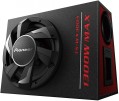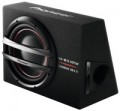Type
—
Active. Subwoofer equipped with its own built-in amplifier. Such a subwoofer can be connected directly to the signal source, without any additional amplifiers; while the built-in amplifier, by definition, has characteristics that best match the parameters of the speaker. And when using other amplifiers, an active subwoofer reduces the load on them, which has a positive effect on sound quality and power. In addition, your own amplifier can be equipped with its own sound tuning tools and other additional features. On the other hand, all this affects the cost of the device, and active models are somewhat more difficult to install, because. require separate power supply.
—
Passive. Subwoofers not equipped with their own amplifier. They are cheaper than active ones and easier to install. work without a separate power supply, however, the connection is fraught with some difficulties: for normal operation, an amplifier is needed, the characteristics of which (in particular power and impedance, see below) must optimally match the parameters of the subwoofer.
Frequency range
The range of audio frequencies reproduced by the subwoofer. It is believed that the human ear is capable of perceiving a frequency range of the order of 16 – 20,000 Hz, but in this case note that the subwoofer is designed to reproduce the lower frequency band (up to 200 Hz). Accordingly, in the case of the lower limit of the range, everything is simple: “the lower, the better”; the upper one should not be lower than the lower limit of the main car audio — otherwise there will be "gaps" in the frequencies, which will affect the sound quality.
Sensitivity
Sensitivity determines the loudness of the subwoofer when a signal of a certain power is connected to it: with equal signal power and impedance (see below), the subwoofer with the higher sensitivity will sound louder.
Resonant frequency
The natural frequency of the cone in the subwoofer speaker, namely the frequency with which the cone will oscillate if the speaker is suspended freely in the air and a single impulse is transmitted to the cone (for example, by clicking on it with your finger). In subwoofers, this parameter determines, in particular, the lower limit of the frequency range (see above): at frequencies below the resonant sound power drops sharply. Accordingly, for deep rich bass, the resonant frequency should be as low as possible. This parameter is also used to calculate the size of the enclosure for the subwoofer.
Bass level control
Since the subwoofer was originally designed to reproduce bass, in fact, in this case, it implies the presence
of its own volume control, which allows you to change it without affecting the signal source. This allows you to easily set the desired bass level relative to the rest of the sound of the audio system (for different cases, this ratio may be different).
High voltage input
The presence of a
high-voltage input at the active (see "Type") subwoofer. Such an input greatly expands the possibilities for connection. Usually active subwoofers are connected via a linear (low-voltage) input directly to the radio. The high-voltage input allows you to connect the speaker to a separate power amplifier, like a passive subwoofer.

